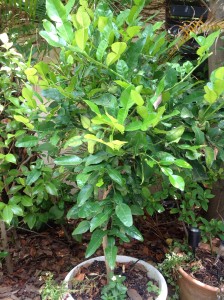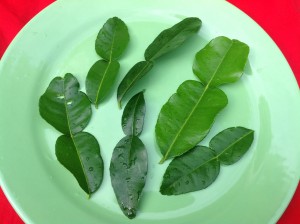If you have the space in your garden or on your balcony, consider obtaining a kaffir lime tree for both looks and flavours. We have had one surviving quite happily in a large planter pot for about ten years. It hasn’t ever grown actual fruit, but we use the leaves frequently, picking them almost as often as we pick leaves from our bay tree.
While the leaves or fruit are often found in Thai cooking, they are widely used in South East Asian cooking in general. They impart distinctive flavours that are difficult to emulate, with lemons, limes or lemongrass not providing the same result. The leaves in particular have qualities that can be used way beyond South East Asian cuisine: they are often a suitable substitute for bay leaves, (for example, when stuffing a chicken or fish or marinating meat) or try them in desserts (for example, there are many versions of kaffir lime flavoured panna cotta).
Valerie is a natural, inventive cook. She prepares great get-together feasts for guests at her home in Adelaide.
One time when visiting us in Melbourne, she noticed our kaffir lime tree and gave us her method for kaffir lime leaf pesto. It can be used on whatever you fancy – a teaspoon in a salad, a dash in a sandwich or wrap, with barbecued meat, with a roasted chicken, in a soup, or to liven up a curry. It has a strong, distinctive flavour, so not much is needed.
You can make a decent batch using a blender and then freeze in small amounts. Or you can make a small amount from several leaves using a mortar and pestle: you will see that the amount of pounding and elbow grease needed certainly qualifies the mixture to be called a ‘pesto’!
Pick leaves from around the tree, including some older and newer ones – the older tougher leaves might not work as well for this sauce. To encourage our kaffir lime tree to bunch and thicken, we occasionally prune 20 to 30 cm off the branches as they form. We generally use the leaves on these prunings to make a batch of this pesto.
When you have finished blending, there may be a significant amount of residual oil and tiny pieces in the bowl or container that have plenty of flavour. Thus, follow it up with a standard pesto or one with lots of parsley to achieve a slight kaffir lime flavour. Or make a chimichurri sauce as that has some liquid in it (water and vinegar) which can be used to rinse out the container to be used in the chimichurri.
For the recipe, click here: Kaffir Lime Leaf Pesto



